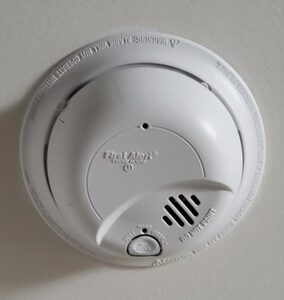BLOG
Smoke Alarms Help to Defend Against Injury or Even Death
 Smoke alarms are an important defense against injury or death in house fires.
Smoke alarms are an important defense against injury or death in house fires.
Here’s what you need to know: As in real estate, location is key! Smoke alarms are best installed in bedrooms or outside every sleeping area, and on each level of the home.
It’s best to follow the manufacturer’s instructions for placement, whether on the wall or ceiling. High, peaked ceilings have dead air space at the top; in these instances, smoke alarms should be placed no closer than three feet from the highest point.
For the most comprehensive protection, both types or a combination unit should be installed.
There are several types of smoke alarms
There are two main types of smoke alarms: Photoelectric smoke alarms: those that use photoelectric detection. And ionization smoke alarms: those that use an ionization for detection. Ionization detectors are more common because they are generally mass produced and typically, it is an inexpensive unit, but the photoelectric detectors are affordable as well.
Ionization detectors are best at detecting flaming fires, while photoelectric alarms are usually more sensitive to smoldering fires. The best idea is to either have a combination of the two types of alarms or find one smoke detection device that utilizes both types of detection.
You should test your smoke alarm often
Smoke alarms should be tested at least once a month to ensure it is functioning properly. Most alarms have a test button. Simply hold the button for a few seconds and see if the unit’s alarm sounds. If you don’t hear it, or it is faint, it’s time to replace your batteries. Keep your family safe by remembering to check these life-saving devices regularly.
You should change your batteries at least once a year
If you don’t change your detector’s batteries, you’ll likely hear that annoying high-pitched periodic chirp until you do. While the sound is grating, it does an excellent job reminding you when the battery is low, and it is time for a fresh one. If you are not sure whether or not the battery is dead, test it in a non-safety device.
A good rule of thumb for battery replacement
When in doubt, throw it out. It’s always better to be safe than sorry. It never hurts to give your fire alarm a fresh new battery even if you aren’t sure if the last one is dead. When you replace the batteries, consider writing the date on the new battery with a permanent marker so when it dies, you can see how long it lasted and know approximately how long each battery will work in your alarm.
Combination alarms are available
Arguably even more dangerous than a fire is carbon monoxide poisoning. Carbon monoxide gas is odorless and tasteless, yet extremely toxic, and therefore extremely dangerous. It is produced by vehicles and gas-powered furnaces and unsafe levels of it cause hundreds of deaths each year. If possible, look for a fire alarm that also includes a carbon monoxide detector.
